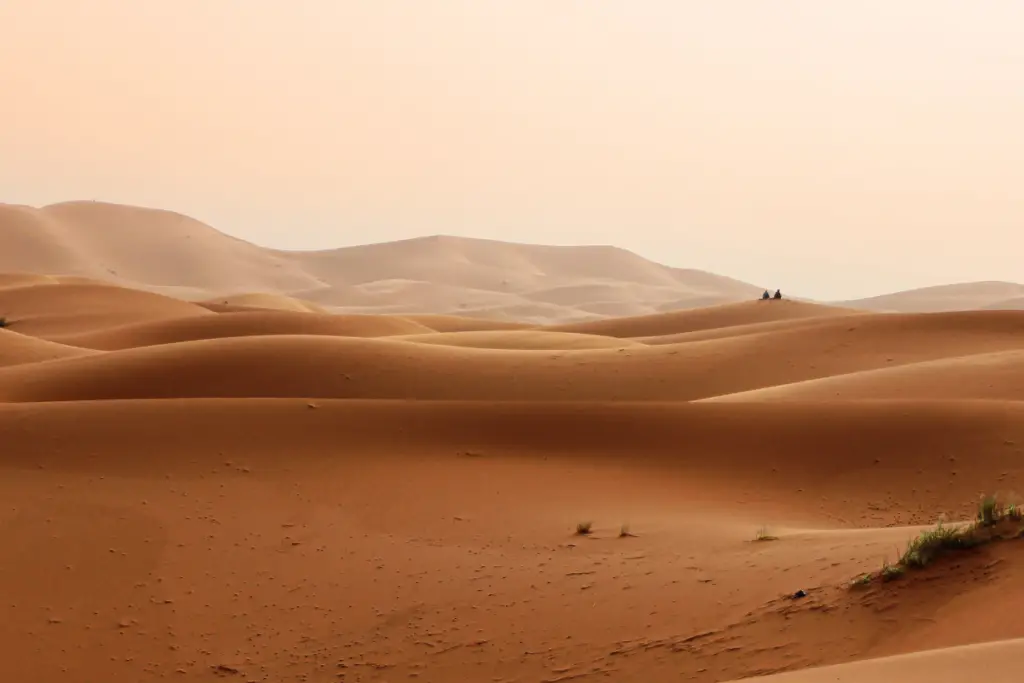Subtropical deserts exist between 15o and 30o north and south latitude and are centered on the Tropic of Cancer and the Tropic of Capricorn.
Deserts are often found on the leeward or lee side of mountain ranges, creating a rain shadow after prevailing winds drop their water content into the mountains. A good examples are Mohave and Sonoran deserts. Deserts in other regions, like the Sahara Desert in North Africa or the Namib Desert in South West Africa, are arid due to the dry high-pressure air that falls at those latitudes.
Subtropical deserts are very arid; evaporation typically exceeds precipitation. Subtropical hot deserts can reach daytime soil surface temperatures above 60oC (140o F) and nighttime temperatures can fall to 0oC (32o F). Subtropical deserts are defined by low annual precipitation of fewer than 30 cm (12 in) with little monthly variation and lack of predictability in rainfall. Some years may receive tiny amounts of rainfall, while others more. The annual rainfall can be low as 2 cm (0.8 in) in subtropical deserts located in central Australia and northern Africa.
The low biodiversity of this biome is closely related to its low and unpredictable rainfall. Despite relatively low diversity, desert species show fascinating adaptations to the harsh environment. Very arid deserts lack perennial vegetation that lives from one year to the next; Instead, many plants are annuals that grow rapidly and reproduce when it rains, then die.
Perennial plants in deserts are defined by adaptations that conserve water: deep roots, small leaves, and water-storing stems. Seed plants in the desert produce seeds that can be inactive for long periods between rains.
Dominant plants: cacti and other succulents; creosote bush and other plants with short growth cycles.
Most wildlife in subtropical deserts is adapted to a nocturnal life, spending the hot daytime hours beneath the ground.
Dominant wildlife: predators such as mountain lions, gray foxes, and bobcats; herbivores such as pronghorn antelope, mule deer, desert bighorn sheep, and kangaroo rats; bats; birds such as hawks, owls, and roadrunners; insects such as ants, beetles, butterflies, flies, and wasps; reptiles such as tortoises, rattlesnakes, and lizard.
The Namib Desert is the oldest desert on earth and has probably been dry for more than 55 million years. Because of this old age, it supports a number of endemic species (species found only there). For example, the unusual gymnosperm Welwitschia mirabilis is the only extant species from an entire plant order. There are also five reptile species that are considered endemic to the Namib.
In addition to subtropical deserts, there are cold deserts that freeze during the winter, and each precipitate is in the form of snowfall. The largest ones are Gobi Desert in northern China and southern Mongolia, the Taklimakan Desert, Turkestan Desert, the Great Basin Desert of the United States.

Erzsebet Frey (Eli Frey) is an ecologist and online entrepreneur with a Master of Science in Ecology from the University of Belgrade. Originally from Serbia, she has lived in Sri Lanka since 2017. Eli has worked internationally in countries like Oman, Brazil, Germany, and Sri Lanka. In 2018, she expanded into SEO and blogging, completing courses from UC Davis and Edinburgh. Eli has founded multiple websites focused on biology, ecology, environmental science, sustainable and simple living, and outdoor activities. She enjoys creating nature and simple living videos on YouTube and participates in speleology, diving, and hiking.

